
Newton Lessons for Apple's New Platform
This article is translated to Serbo-Croatian language by Anja Skrba from Webhostinggeeks.com.
Apple’s press releases all end with the phrase “Apple ignited the personal computer revolution in the 1970s with the Apple II and reinvented the personal computer in the 1980s with the Macintosh.” Today, Apple is building a new platform, and applying lessons it learned from the 90s.
During that nearly forgotten epoch of upheaval and crisis, Apple tried to launch the Newton as a new platform, although its subsequent failure in the marketplace didn’t earn it a mention in Apple’s press release blurb.
The Newton wasn’t just a new gadget, it was intended to be a diverse platform. Like the Macintosh from the prior decade, the Newton started as one product, and intended to branch out into a range of systems.
Introducing the Newton
Apple used “Newton” to describe its operating system for a series of devices, including the MessagePad line of PDAs and the later eMate mini laptops it marketed to schools. Prototype Newton devices included phones, video walkie-talkies, a tablet-like slate, and a mini PDA device similar to the Palm Pilot.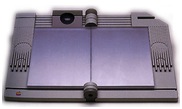

The original intent of the Newton project was not to design a PDA, but to deliver a new tablet-based computer that would leap over the existing Mac user interface. This new interface was described in Apple concept videos including Knowledge Navigator and Future Shock.
The brand new, futuristic user interface was intended to be powered by a similarly futuristic programming language called Dylan. It provided an object oriented, dynamic development environment inspired by Lisp and Smalltalk. Dylan was so futuristic that it even the Newton wasn’t quite ready for it.
Newton, Interrupted
Apple decided that introducing an entirely new computer platform would distract from the Macintosh. It was already struggling to update System 7 and deliver the next generation Pink for the Mac, and was even still selling the Apple II line, so launching another new competing system would just fracture things further.
The Newton project was instead positioned as a new peripheral for the Mac: a highly portable, handheld digital assistant that would sync data from a standard computer rather than replace it entirely.
Technical Innovations
Newton traded the futuristic Dylan for NewtonScript, an easier to use syntax based upon the Self language. It still pushed the state of the art in object oriented coding, automated memory management, and what is today referred to by Microsoft as managed code.
Another new idea pioneered on the Newton was the idea of data soups. Rather than using a more conventional file system, Newton data was stored in soups: object oriented databases. This is similar to the Object File System Microsoft had promised for 1991’s Cairo, and again for 2001’s Longhorn, but was never able to actually deliver.
Soups put data into shared pools that various applications could draw upon; soups of calendar and contact information could be referenced by any app, not just the one that created a file, as was commonly the case on standard computers. The idea of soups worked well on the device, but complicated syncing to a computer.
The Newton’s object oriented system also allowed plugins to add dramatic new functionality to existing applications. Many of these innovative ideas are just now being applied today, a decade later.
Newton had been a pet project of CEO John Sculley, who hyped up the Knowledge Navigator concept and coined the term “personal digital assistant” when demonstrating a prototype Newton at the January 1992 Consumer Electronics Show in Las Vegas.
Apple rushed to deliver the first MessagePad over the next year and a half, the same year Sculley was asked to leave the company.
Shortly after his departure, the first Newton was released in August of 1993. Four slightly improved models followed in the next three years, but Apple wasn’t impressed with its sales. They cost $700-900.
In 1997, Apple shipped a dramatically improved version called the MessagePad 2000, along with the $800 eMate 300, which was originally sold only to schools. Apple also licensed the Newton OS to Sharp and Motorola for use on their PDA products.
As Apple struggled to cope with its increasingly serious core problems, it first spun Newton off as a subsidiary, and then later dismantled it in early 1998 to allow the company to focus on projects that were profitable enough to sustain themselves. Early Newton sales had been unimpressive, and by 1998 it faced increased competition from the much cheaper Palm Pilot.
Newton Competitors: GRiD and Palm
The first pen-based handheld was the 1989 GRiDPAD, a $2,370 specialized DOS laptop with a pen for handwritten input driven by specialized software. GRiD was sold to Tandy and eventually went nowhere in its efforts to break into vertical industrial applications.
GRiD’s founder, Jeff Hawkins, wanted to turn the ideas behind GRiD into a consumer device. He licensed the GRiD software from Tandy and set up his own company, Palm Computing, to build a software platform for a consumer PDA called the Zoomer.
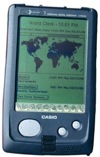

After Zoomer failed, Palm turned to writing applications for other handhelds, including the Newton. One of those applications was Graffiti, which allowed simple text input as an alternative for the Newton’s commonly criticized whole-word recognition.
After failing to find support for a Zoomer 2, Hawkins decided the market really wanted a simpler, smaller, and cheaper device. Palm retooled to build that in the $300 Pilot for US Robotics in 1996. In 1997, sales of the Palm Pilot took off, leaving little growth potential for the significantly more expensive Newton.
After 3Com bought up US Robotics, Hawkins and other Palm founders left to start Handspring, a licensed Palm cloner. Handspring focused on turning the Palm into a phone, resulting in the Visor phone add-on and the Treo.
In 2003, Handspring merged with the struggling remnants of Palm, giving the company a phone product to sell as the market for PDAs tanked. Palm’s current situation makes Apple’s prospects in 1996 look great in comparison.
Newton Competitors: GO
Go Computing delivered the PenPoint OS as one of the first operating system specifically designed for handheld systems.
PenPoint presented an interface following the metaphor of a tabbed notebook, aiming to be simple and easy to use. Go licensed PenPoint to various companies, including GRiD.
AT&T released its short-lived EO Personal Communicator running the PenPoint OS in 1993. Two wireless models were priced at $2000-$4000. The project ran out of funding and went under just a year after its launch.
The demise of Go as an operating system vendor is largely attributed to the threat posed by Microsoft’s Windows for Pen Computing, which promised to eat up the entire market for pen based tablets and PDAs.
Newton Competitors: Microsoft
It turned out that Windows for Pen, a product designed to extend upon Windows 3.0 to provide tablet features, didn’t do anything but threaten rivals. Once any threat from Go was terminated, Microsoft dropped it.
A new Microsoft vision for the future of pen computing was announced in 1992’s WinPad. Following the business plan of Go, Microsoft signed up support from Compaq, Motorola, NEC and Sharp to build new WinPad Handheld PCs, but by 1994 Microsoft had abandoned WinPad as unworkable vaporware.
The next year, in place of the aborted WinPad, Microsoft announced a far more advanced, 32-bit, high powered project for a new Handheld PC called Pegasus. It was delivered in the end of 1996 as Windows CE 1.0.
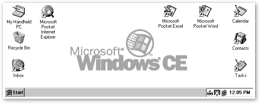 WinCE didn’t offer anything like the Newton from three years prior; it looked more like Windows 95 stuck in a small screen.
WinCE didn’t offer anything like the Newton from three years prior; it looked more like Windows 95 stuck in a small screen.It didn’t perform, had poor battery life, and it was tied to Microsoft’s own software, particularly Outlook. However, it was from Microsoft, so the world was assured by leading analysts that it would eventually catch up and overtake the competition.
In 2000, I won a raffle held by Compaq that awarded me a brand new WinCE device. It was clunky, with a horrible user interface, too slow to use, had no battery life, and was still tied to Microsoft’s own software. It made the Palm V I already had look like a magical object dropped from the future by a superior alien race.
After a decade of million dollar losses, Microsoft is at WinCE 6.0. A specialized, mini version of Windows turned out to be a highly unprofitable venture, and attempts to retread WinCE in smartphones, WMA music players, the Sega DreamCast video game console, and other embedded applications have all been failures.
High development costs and little prospects for sales have driven Microsoft to an upside down “shared source” program for WinCE, where it provides its software code to licensees, but can then claim royalty free rights to all improvements they make. You write it, okay?
WinCE has been downplayed recently as attention is focused on new devices running a specialized version of the standard desktop Windows. Origami, the latest take on Tablet PC failure, fell apart just this year.
In fact, when cnet.co.uk reviewed a 2006 Origami product, the Samsung Q1, against the 1997 Apple Newton MessagePad 2000, it awarded the decade old Newton as the overall winner.
Back to The Macintosh
While the Newton as a product ended up as a commercial failure, there is no question that Apple's earlier Macintosh ushered in a new world of computing, even if Apple wasn’t the main beneficiary of its innovations.
Elements of the Mac can be traced to Xerox PARC, and even back into the 60s with Douglas Engelbart's work in mouse driven computing.
Of course, those concepts were also available to others, including IBM prior to the release of its PC and of course Xerox itself, so Apple deserves credit for bringing them into the mainstream.
Apple also deserves credit for operating system work and user interface developments that were wholly unique. Researchers at Apple developed consistency guidelines that solved real problems for users and allowed developers to build applications that focused on adding new features, rather than reinventing the wheel.
Apple's prior success with the Apple II, combined with its size and industry position, helped the company to remain in business as the rest of the world fled to the PC and abandoned companies like Atari and Amiga, who could not keep up with the brutal competition and rapid changes happening in technology.
Those favorable circumstances gave the Mac certain advantages; had Apple been managed differently in the late 80's, its position might not have been so easily overtaken by its rival, Microsoft. Today however, a similar set of circumstances provide Apple with another clear shot at delivering the future.
A New Platform Needed
The solution, like the Mac twenty years ago, has a lot to do with Apple's core competencies of user interface design and its simple and intuitive solutions provided though integrated products.
Today's problem is mobile phones, and music players, and car stereos, and TVs, and video games, and content delivery, and the software that powers it all. Just like DOS apps from the 80's, today's devices each use custom user interfaces with randomly chosen controls that expose excessive complexity to users.
This collectively causes a problem not just in usability, but in selling software to run and extend the functionality of various devices. Nothing is compatible with anything else.
In the mid 90's, Sun's Java promised to run applets everywhere, and Linux promises to power everything with a single code base, but neither have actually solved the problem of compatibility. Similarly, neither do anything to fix broken user interfaces, apart from perhaps making things worse.
Microsoft has worked to deliver WinCE and specialized versions of its standard Windows to power a variety of devices, from tablet PCs to Origami to TV set top boxes, but all of its efforts have failed miserably. Similar efforts by Palm to power extended PDAs, Treo phones, and larger tablet devices have also been underwhelming.
This time, the answer isn't a new operating system that runs everything. In fact, the operating system doesn't matter anymore. The real need is a usability layer.
To draw further comparison with PC applications: the solution is Windows, not the underlying DOS or NT kernel laying below it. Or in Apple parlance, its the Mac user interface, not the System 7 or UNIX below it.
The new platform that consumer electronics devices need is an overall system; a consistent user interface is a significant part of this. Apple attempted to deliver this in the Newton, but it tried to offer too much, and simply ended up being too expensive and over-architected for the mass market.
Why Newton Failed
The Newton actually suffered from a number of fatal flaws; some of its issues relate to Apple's new platform, which promises to solve many of the same issues that Newton was intended to cover. The main problem with the Newton was in its hardware execution: turning the concepts behind it into a product that could sell.
Brant Sears, a developer of what was the most successful medical software for the Newton, reported his perspective in an email that offers an interesting inside look at why the Newton failed. He wrote:
-
•Apple pre-announced the Newton before it was ready. John Sculley's demo of the product almost two years before it shipped was a real mistake and forced Apple to rush Newton out the door before it was finished.
-
•The Newton was too slow; certain actions just took too long. Scrolling through notes on the original MessagePad was painfully slow because the operating system and most of its software was interpreted NewtonScript running on a virtual machine. Apple made that choice to use less flash memory. It did make the system really elegant, but at the price of performance on early systems.
-
•The Newton was physically too large.
-
•Apple's sales expectations were far too high. The Apple II sold 16,000 units the second year it was out and was considered a huge success. The Mac sold 60,000 units its first year and was considered a modest success. The Newton sold over 100,000 units its first year and was a "flop."
-
•The handwriting system on the original MessagePad was designed to recognize entire words rather than letters. This was because focus group data told Newton engineers that people would insist on being able to write in cursive. When the system made a mistake, it would pick a valid word that was different than the one intended leading to hilarity and ridicule.
To add insult to injury, the PDA market was totally fine using Graffiti, which was a cheese-ball solution. The Newton group had considered and rejected solutions like that. They did fix handwriting recognition in Newton OS 2.0, but it was too late. -
•Apple never provided a good data synchronization solution or good third party libraries for data sync, and kept too much information secret for third party developers to fix it for them. In 1998 the DIL sync libraries were still alpha. Trying to develop anything using the DILs was extremely frustrating because Apple was thrashing: creating new APIs, pre-releasing some libraries, then abandoning them and starting over again.
-
•There were electrical problems that caused all kinds of bad issues for third parties trying to do things with wireless ethernet cards. For example, Xircom cards drew too much power for the Newton 2000 to work with regular batteries, requiring the use of Apple's rechargeable battery. Unfortunately, it would only last one or two hours with the wireless card. The battery was a weird shape and Apple didn't make an external charger for it.
You might argue that this was a corner case. However, Apple met with us and told us that our product was going to "make or break" the MessagePad 2000 and the Wayfarer wireless system we were trying to use had been designed and built with Apple's help long before the MP2K ever shipped (we were trying real hard to ship something on the MessagePad 120). Ultimately, our software company made one hardware product - an external battery charger for the MP2K batteries. -
•The Newton Interconnect Port on the MP2K, and lack of a serial port, caused the device to be a serious pain because users had to carry a serial adapter in order to use it. Any time anyone else in the organization (especially sales) handled an MP2K unit, they lost the dongle. Apple did absolutely nothing with the Newton Interconnect Port. Nothing. Nada. So, this huge pain in the ass design tradeoff was for nothing.
Death by Impracticality
"The bottom line,” Sears observed, “was that Apple created something really cool and almost usable with the Newton. But unlike now, Apple products of that era were often great, but had one or two fatal flaws that prevented them from actually being practical to use.
“This was true of many, many things. One that comes immediately to mind was the QuickTake cameras. I have a QuickTake 200. It’s okay, but requires four high energy lithium AA batteries. These batteries are super expensive and the QuickTake chews through them the way my daughter chews through candy.
"Also, in the 90s it seemed like Apple was releasing many technologies and products that were "one off". They shipped, got no marketing, no follow through, and were abandoned, like Newton Bookmaker, Virtual User, Apple Dylan, The Macintosh TV, and others. It really seemed random.
“Somewhere I have a pair of Apple headphones circa 1996. Up until the iPod was released I used to show these to people and they would be baffled: why would Apple make headphones? Especially since they were very expensive, very boring, low quality headphones. You could buy better headphones anywhere for $5 and these were more like $50. I'm sure they were part of some multimedia initiative, but they were just sold at Microcenter, hanging on a hook on the wall, sold as a separate product. Everyone who saw them at Microcenter, I'm sure, wondered what color the sky is in Cupertino.
The Critical Shift
"The reason why Apple is great today, I think, comes down to this: They still do great things. But sometime before they ship, Jobs would look over the product from the point of view of a user and run his mind across the steps necessary to use the product. He looks for reasons why the product would not actually be useful.
“On the iPod, someone looked at it and figured out answers to questions like "How do I charge it?", "How often do I need to charge it?", "How do I load the music?", "Where do I get the music?", "How do I select a song?" These boil down to "Could a person actually use this product? Are there fatal flaws? Would a person actually use this product? What is the problem being solved? How does this product solve the problem better than the current solution?"
Sears' comments reinforce the shift Apple has made from a directionless producer of fairly random products to a relentlessly competitive tech design company. The same principle of thoughtful consideration for usability is also being used to develop an overall platform that powers today's iPod.
Soon, that platform will extend to an increasingly wide set of devices related to the iPod. The next segment will look at the existing problems in consumer electronics, and why Apple is in a position to solve them.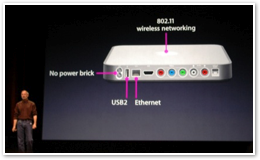

Next Article:
This Series










Monday, December 11, 2006
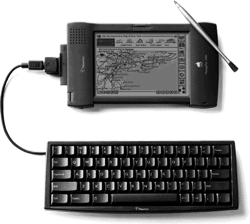
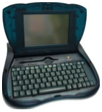
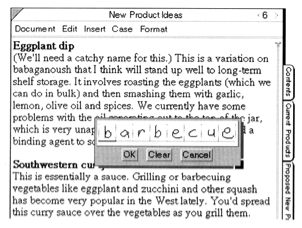

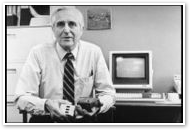

 Bookmark on Del.icio.us
Bookmark on Del.icio.us Discuss on Reddit
Discuss on Reddit Critically review on NewsTrust
Critically review on NewsTrust Forward to Friends
Forward to Friends
 Get RSS Feed
Get RSS Feed Download RSS Widget
Download RSS Widget





